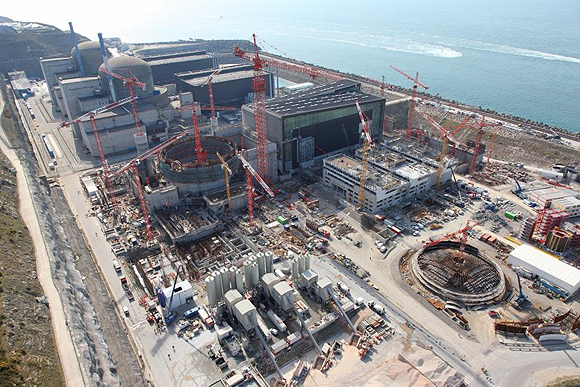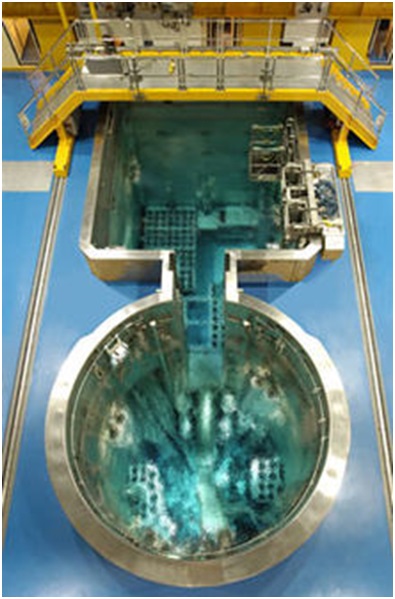
Blog
-
Geiger Readings for June 16, 2015
Ambient office = 97 nanosieverts per hourAmbient outside = 109 nanosieverts per hourSoil exposed to rain water = 82 nanosieverts per hourMango from Central Market = 88 nanosieverts per hourTap water = 107 nanosieverts per hourFiltered water = 101 nanosieverts per hour -
Nuclear Reactors 256 – Serious Problems in the U.K. Hinkley Point EPR Project
I have posted in the past about problems with the Hinkley nuclear power plant project in the U.K. The French EDF company has been contracted to build a pair of nuclear reactors based on the new European Pressurized Reactor (EPR) design at Hinkley Point with international financing and a guaranteed price for the electricity generated. The project has been embroiled in controversy since its inception and problems keep multiplying.
The EPR design itself has now been called into question. EDF has been building an EPR reactor at Flamanville in Normandy to serve as a “showcase” for the design. There has been a five year delay in completion of the project as well as costs rising above original estimates. The French Nuclear Safety Regulator recently produced a report on faults with the Flamanville cooling system. The leaked report also complained that there was too much carbon in the steel used to construct the reactor. A source in the U.K. Treasury department commented that there are “serious questions” about the EPR technology.
It has been difficult to find financing for the project. There have been complications with respect to the portion of the project that can be legally owned by foreign governments and companies. EDF was supposed to come up with a five percent share of the money but due to financial problems, it now appears that EDF may not be able to supply the promised money. The negotiations between the U.K and EDF with its two Chinese partners was supposed to completed in March but it is now June and the negotiations are still going on. Now a new deadline of October has been announced.
The U.K. government has signed an agreement that guarantees a fixed price for the electricity generated by the new Hinkley point reactors for thirty five years regardless of fluctuations in the market price of electricity. The U.K. has promised to guarantee about twenty five billion dollars of the debt incurred by the project but also says that there are conditions to relieve taxpayers of the debt guarantee if the technology fails. The agreement says that the shareholders in the project will be liable for the twenty five billion dollars of debt if there are problems with the EPR technology until France can prove that the EPR technology at Flamanville works as advertised.
Supporters of the Hinkley project in the U.K. government and the nuclear industry are expressing suspicions that the Treasury department has been “dragging its heels” on the project. They say that the Treasury fears that the guaranteed price for electricity is much too generous and may prove a burden on the U.K. ratepayers. Some critics of Treasury go so far as to say that they would not be surprised if Treasury officials would just as soon see the project abandoned.
It seems to me that with all the unresolved problems and concerns about safety and finances, the U.K. might be better off dropping the Hinkley Point project before more money and time is wasted.
French Flamanville EPR construction:
-
Radiation News Roundup June 15, 2015
-
Geiger Readings for June 15, 2015
Ambient office = 97 nanosieverts per hourAmbient outside = 109 nanosieverts per hourSoil exposed to rain water = 82 nanosieverts per hourYellow bell pepper from Central Market = 125 nanosieverts per hourTap water = 73 nanosieverts per hourFiltered water = 67 nanosieverts per hour -
Radiation News Roundup June 14, 2015
-
Geiger Readings for June 14, 2015
Ambient office = 74 nanosieverts per hourAmbient outside = 114 nanosieverts per hourSoil exposed to rain water = 120 nanosieverts per hourYellow bell pepper from Central Market = 128 nanosieverts per hourTap water = 58 nanosieverts per hourFiltered water = 53 nanosieverts per hour -
Radiation News Roundup June 13, 2015
A professor from Japan’s Fukushima University Institute of Environmental Radioactivity (Michio Aoyama) told Kyodo in April that the West Coast of North America will be hit with around 800 terabecquerels of Cesium- 137 by 2016. washtingtonblog.com
Could the Islamic State build a nuclear weapon? catholic.org
-
Geiger Readings for June 13, 2015
Ambient office = 52 nanosieverts per hourAmbient outside = 76 nanosieverts per hourSoil exposed to rain water = 70 nanosieverts per hourRedleaf lettuce from Central Market = 75 nanosieverts per hourTap water = 56 nanosieverts per hourFiltered water = 50 nanosieverts per hourDover sole – Caught in USA = 99 nanosieverts per hour -
Nuclear Reactors 255 – Australia Building New Facility to Produce Radioistopes for Nuclear Medicine
I have written in the past about problems with the supply of critical radioisotopes for medical uses. The U.S. and Canada are working on new methods for creating the radioisotopes and hope to make up the shortfall soon. The Australian Nuclear Science and Technology Organisation (ANSTO) Lucas Heights OPAL reactor in Sydney, Australia is working on increasing its production of nuclear medicine.
Since the OPAL reactor started operations in 2006, it has produced four million doses of nuclear medicine. It produces about ten thousand doses a day that supply two hundred and fifty hospitals around Australia. Small amounts of radioactive materials are used to “diagnose, treat and determine the severity of a variety of diseases.” This process can assist in “the diagnosis of many types of cancers, heart disease, gastrointestinal, endocrine, neurological disorders and other abnormalities.” According to estimates, one out of every two Australians will have illnesses diagnosed and treated by nuclear medicine some time in their life.
A new production plant is under construction that expand production to thirteen million doses a year. ANSTO is planning on taking advantage of the fact that most of the world’s nuclear reactors are almost sixty years old and their design does not permit them to produce large amounts of medical radioisotopes. The new facility will be able to produce over twenty five percent of the global demand for nuclear medicine. The isotopes that the new plant can produce are used in eighty percent of the nuclear medicine procedure around the world.
The HIFAR reactor put into operation at Lucan Heights in 1958. In 2006, it was replaced by the OPAL reactor which became the only operating reactor in Australia. Unlike the Fukushima site, the Lucas Heights site is geologically stable and miles from the coast. The waste generated by the OPAL reactor has been shipped to France in the past for reprocessing but that arrangement is ending and intermediate waste is being shipped back to Australia. Nuclear medicine production constitutes thirty percent of the business activities at Lucas Heights but it generates over eighty percent of the waste. ANSTO has allocated over twenty two million dollars this year for the refit of two waste storage facilities which will take four years.
The Lucas Heights facility has been the center of controversy and protests for decades. Anti-nuclear activists oppose the existence of a nuclear reactor on the outskirts of Australia’s largest city. ANSTO claims that the Lucas Heights site is “one of the most secure infrastructure facilities in the country.” The protestors complain that there is no plan for permanent storage of the waste in Australia and that ANSTO plans to temporarily store it on site at Lucas Heights pose a threat to the citizens of Sydney.
I have blogged in the past about the interest that some parties have in seeing Australia build nuclear reactors for power generation. A nuclear expert has analysed the available commercial reactors in the global nuclear market and concluded that there are no reactors that have a sufficient record of safe operation to be a safe source of Australia electricity. Considering the strong opposition to the OPAL reactor at Lucas Heights, it is obvious that there will be strong public opposition to adopting nuclear power generation in Australia.
OPAL reactor pools at Lucas Heights:
-
Radiation News Roundup June 12, 2015





